Birds are a very important part of the ecosystem of Telangana. The state of Telangana in India is home to a wide variety of bird species, with over 600 species of birds recorded in the state.
The state has a large number of wetlands, which act as breeding grounds for many species of birds. Telangana is home to a large number of migratory birds, who make their way to the state during winter and summer months.
The state has several wildlife sanctuaries and national parks which are home to a wide variety of birds. Some of the most common and easily spotted birds in Telangana are parakeets, kingfishers, cormorants, ducks, and herons.
1. Bulbul
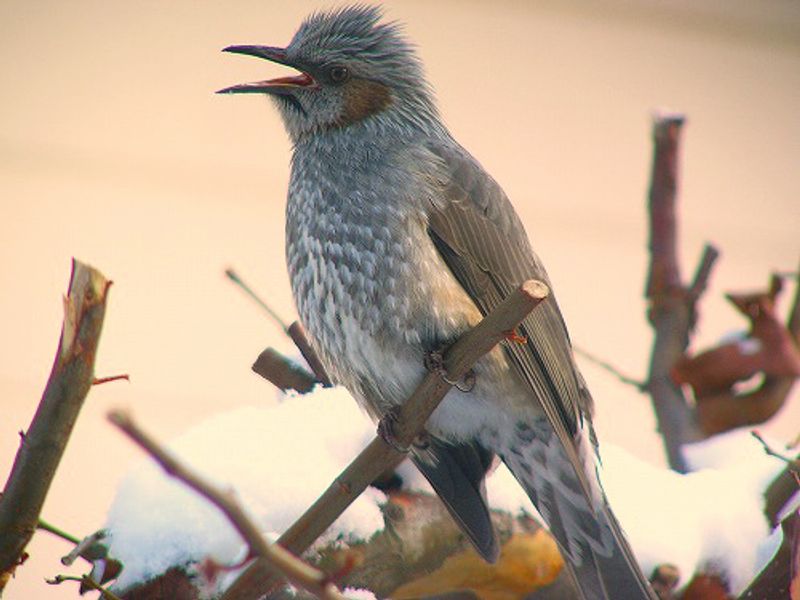
The family Pycnonotidae is composed of medium-sized songbirds known as bulbuls. This family is found in a variety of habitats across Africa, the Middle East, tropical Asia, Indonesia, and Japan.
Bulbuls are closely related to other species known as greenbuls, brownbuls, leafloves, and bristlebills. All of these species are characterized by their colorful plumage, cheerful songs, and adaptability to different climates.
Bulbuls are found in forests, savannas, gardens, and even urban areas where they use their strong beaks to search for food such as fruits, flowers, and insects.
They are also known to make nests in trees or shrubs, which are often built in a cup shape and lined with grass and feathers. In addition to their diet, bulbuls also provide an important ecological role in spreading the seeds of plants and trees.
As a result, they play an important role in maintaining the balance of the natural ecosystem.
| Kingdom | Animalia |
| Phylum | Chordata |
| Class | Aves |
| Order | Passeriformes |
| Family | Pycnonotidae |
2. Iora
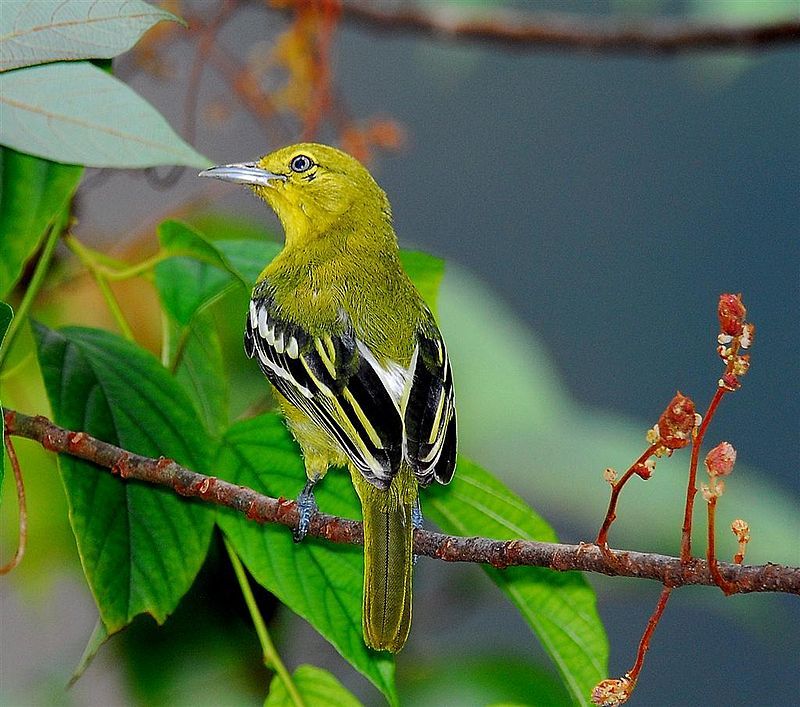
The ioras are a small family of passerine birds found in south and southeast Asia. They belong to the family Aegithinidae, which consists of only one genus, Aegithina. Prior to being placed in the family Aegithinidae, they were part of the family Irenidae.
The family Irenidae includes the leafbirds and fairy-bluebirds, which are similar to the ioras in terms of size and appearance. The ioras are small, vibrant birds, with a length of approximately 13 cm.
They are mainly found in the woodlands and scrublands of India, Pakistan, Bangladesh, and Sri Lanka. They have a short, conical bill and a greyish-brown plumage with patches of yellow or white on the wings. The tail is long and pointed.
Ioras feed mainly on insects and other small invertebrates. They are usually found in pairs, foraging for food in the understory of tropical forests. They are also known to feed on nectar and fruit.
During the breeding season, they build a small cup-shaped nest, which is typically placed in a bush or tree. Ioras are generally quite common and widespread, but their populations have been declining in recent years due to habitat loss and fragmentation.
As a result, they are now listed as vulnerable on the IUCN Red List. Despite this, they are still considered one of the most beautiful and mesmerizing birds in the world.
| Kingdom | Animalia |
| Phylum | Chordata |
| Class | Aves |
| Order | Passeriformes |
| Family | Aegithinidae |
| Genus | Aegithina |
3. Bee-eater
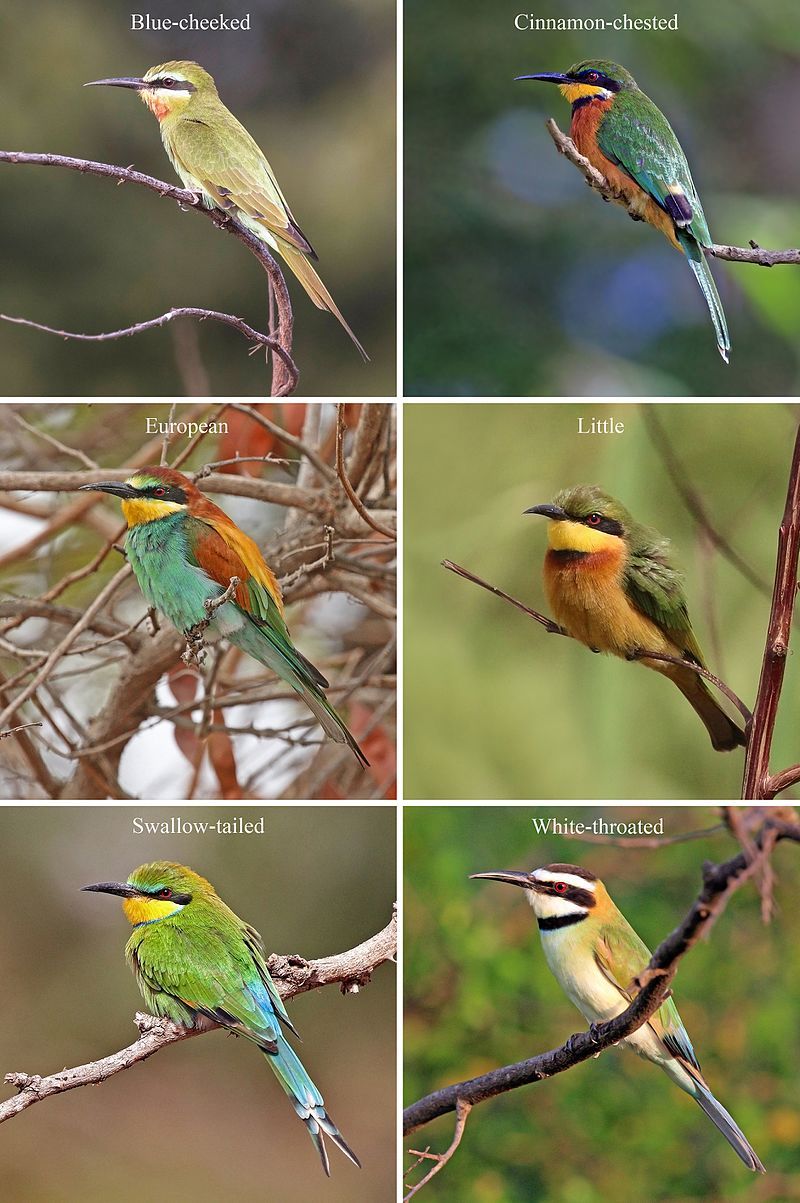
The bee-eaters are an interesting and diverse group of birds belonging to the family Meropidae. They are found in many parts of the world, predominantly in Africa and Asia, with some species also present in southern Europe, Australia, and New Guinea.
They are easily recognizable due to their brightly coloured feathers, slender bodies, and often elongated central tail feathers. The three genera of bee-eaters contain thirty different species in total.
Each species has its own unique characteristics, such as plumage colouration, body shape, and tail length.
For example, the smallest species, the blue-cheeked bee-eater, has a distinct blue patch on its cheeks, while the White-fronted bee-eater has a white stripe at the front of its neck. The bee-eaters are social birds, often seen in large flocks foraging for food.
They feed mainly on insects, such as bees, wasps, and dragonflies, which they catch in mid-air. Their long, slender beaks are perfectly adapted for this type of hunting, allowing them to quickly and accurately snatch their prey.
Bee-eaters are also known for their impressive courtship displays. During the breeding season, males will show off their feathers to attract potential mates. They also perform acrobatic stunts, such as hovering in mid-air and performing complex aerial manoeuvres.
Overall, the bee-eaters are a fascinating group of birds that are well worth studying. From their bright plumage to their impressive hunting skills, they are sure to captivate any bird-watcher.
| Kingdom | Animalia |
| Phylum | Chordata |
| Class | Aves |
| Order | Coraciiformes |
| Family | Meropidae |
4. Phasianidae
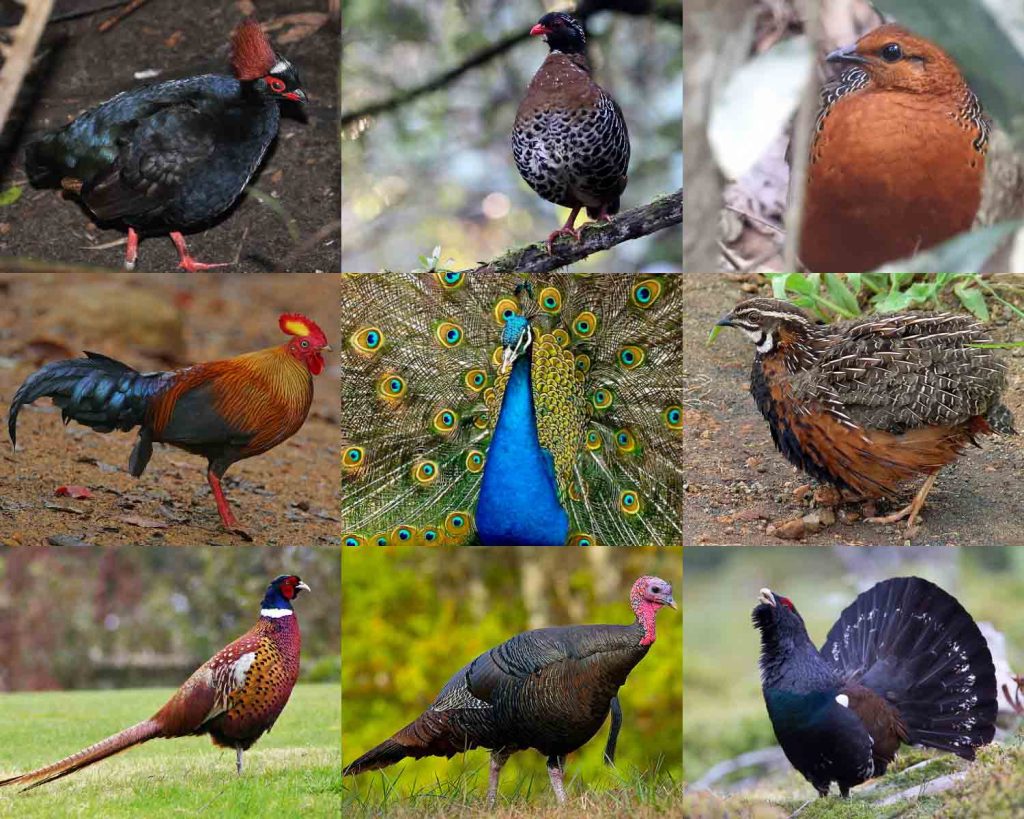
The Phasianidae is an expansive family of birds that live on the ground. This family includes a diverse array of species, such as pheasants, partridges, junglefowl, chickens, turkeys, Old World quail, and peafowl.
This family is a popular source for game birds, as it comprises 185 species divided into 54 genera. The pheasant is the most widely recognized member of the Phasianidae family. These birds have long tails and short wings, which makes them well adapted to living on the ground.
They feed on a variety of seeds, grains, insects, and fruits. Pheasants are used in many hunting activities, and also for their meat and eggs. Partridges are also members of the Phasianidae family. They are much smaller than pheasants and have a rounder body and shorter tails.
Partridges feed on a variety of small insects and seeds. They are also popular for hunting, though they are not as widely hunted as pheasants. Junglefowl are the wild ancestors of domesticated chickens. These birds are found in tropical forests in South and Southeast Asia.
Junglefowl feed on a variety of insects, seeds, and fruits. They are hunted for their meat and eggs, but not as widely as pheasants and partridges. Turkeys are large birds that are native to North and Central America.
They are very popular for their meat and are also used in hunting activities. Turkeys feed on a variety of seeds, grains, and insects. Old World quail are native to Europe, Asia, and Africa. They are much smaller than turkeys and have a rounder body and shorter tail.
Quail feed on a variety of small insects and seeds. They are also popular for hunting. Peafowl are found in tropical forests in Asia. They are known for their stunningly colorful feathers and are popular for ornamental purposes.
Peafowl feed on a variety of insects, fruits, and seeds. The Phasianidae family is a large and diverse family of birds. These birds are popular for game hunting, ornamental purposes, and their meat and eggs.
They have adapted to living on the ground, and feed on a variety of seeds, grains, insects, and fruits.
| Kingdom | Animalia |
| Phylum | Chordata |
| Class | Aves |
| Order | Galliformes |
| Family | Phasianidae |
5. Shrike
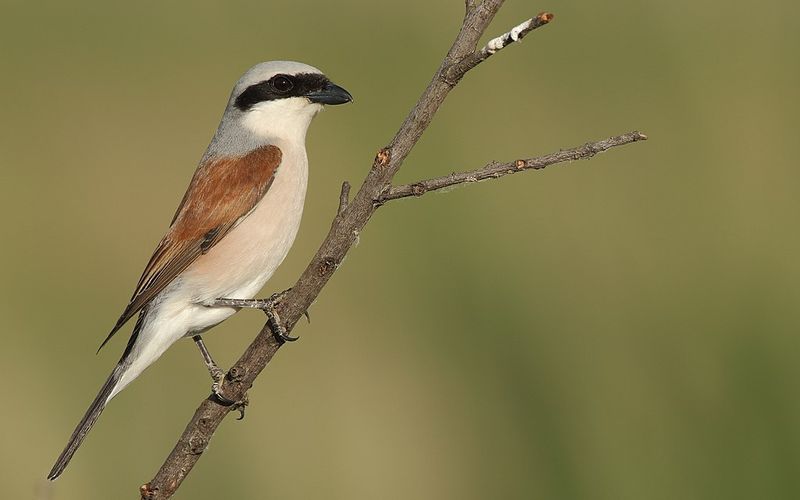
Shrikes are a type of bird that belong to the family Laniidae. These birds are also known as “butcher birds” due to their habit of impaling their prey on thorns or barbed wire. There are 34 different species of shrike classified in two distinct genera.
The two genera are the Lanius and the Eurocephalus. The Lanius genus consists of 21 species of shrike, while the Eurocephalus genus includes 13 species of shrike. Shrikes inhabit a variety of habitats, including deserts, temperate forests, grasslands, and scrublands.
They are mainly found in the Old World, with only two species occurring in the New World. They are usually found near open areas, such as meadows, savannas, and fields. Shrikes are carnivorous and mainly feed on small animals such as insects, frogs, lizards, and small birds.
They hunt by perching on exposed branches or posts and waiting for prey. Shrikes are often identified by their distinctive black and white plumage, as well as their hooked beak. They are usually about 6.7-9.8 inches in length, with a wingspan of 11.8-14.2 inches.
Males and females have similar plumage, though males are usually larger than females. Shrikes are generally solitary birds, but they may form small flocks during the winter months. They are territorial birds and will defend their territories against intruders.
They are also known to be aggressive towards other birds and will often chase away other birds from their territories.
| Kingdom | Animalia |
| Phylum | Chordata |
| Class | Aves |
| Order | Passeriformes |
| Family | Laniidae |
6. Drongos
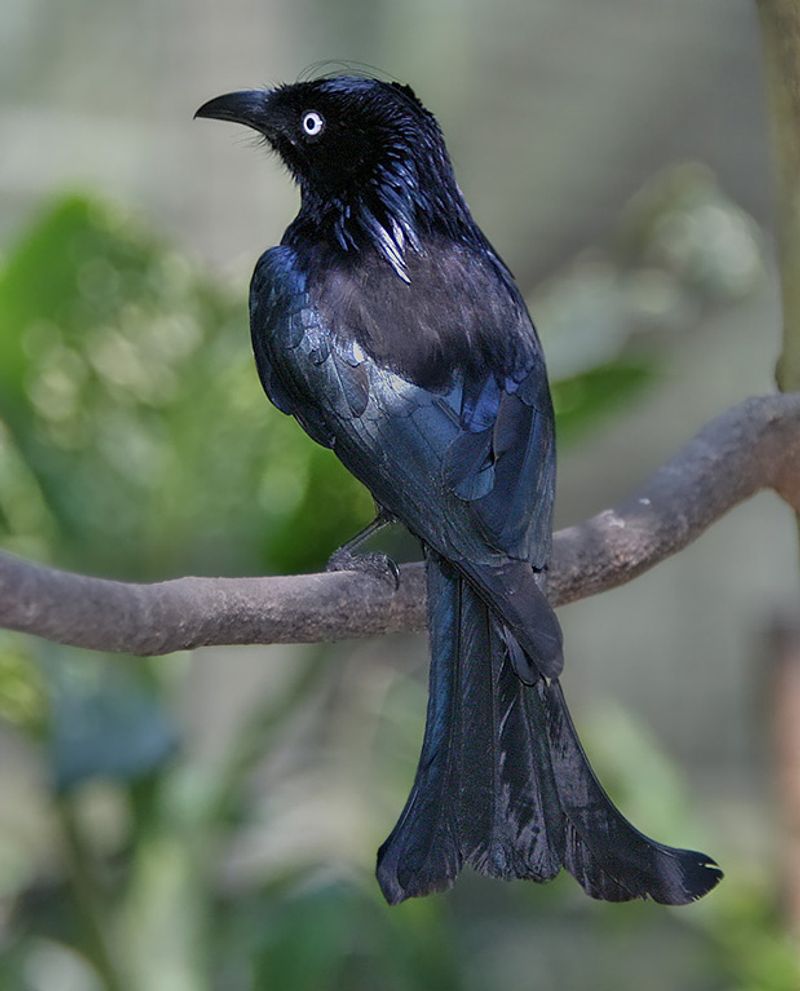
Drongos are a family of passerine birds native to the Old World tropics. This family is known as Dicruridae and consists of 31 species of birds. These birds are all placed in the single genus Dicrurus.
In general, drongos are small, short-legged birds that typically have black or dark grey feathers. When perched, they have an upright stance and have forked tails. Some drongos have more elaborate tail decorations, such as decorations made of feathers.
Drongos are also known for their vocalizations. They produce a variety of sounds, including mimicry of other birds, such as crows and hawks. They also make a variety of other noises, such as clicks and rattles.
Drongos are found in a variety of habitats, including forests, savannas, and grasslands. They are omnivorous, feeding on a variety of fruits, insects, and small animals. They are also known to scavenge for food, such as carrion.
In general, drongos are social birds, often seen in groups of up to 30 individuals. They are also known to form bonds with other birds and even humans. Overall, drongos are an interesting and unique family of birds found in the Old World tropics.
They are characterized by their black or dark grey feathers, short legs, and forked tails. Some even have elaborate tail decorations. They are also known for their vocalizations and social behavior.
| Kingdom | Animalia |
| Phylum | Chordata |
| Class | Aves |
| Order | Passeriformes |
| Family | Dicruridae |
| Genus | Dicrurus |
7. Sandgrouse
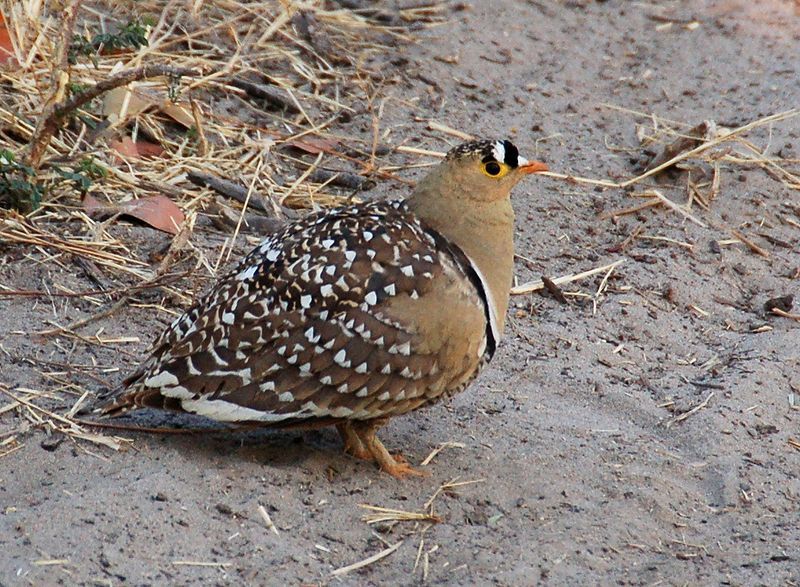
Sandgrouse are a family of birds that are part of the order Pterocliformes. There are sixteen species of sandgrouse, split into two genera.
The two species of sandgrouse that are native to Central Asia are classified as Syrrhaptes, and the other fourteen species of sandgrouse, which are native to both Africa and Asia, are classified as Pterocles.
Sandgrouse are a unique family of birds, with the main feature that makes them distinctive being their ability to store water in their feathers. This is done by using the unique structure of their feathers, which are specially designed to absorb and store water.
This allows the birds to survive in harsh and dry climates, where water is scarce. Sandgrouse have evolved to be able to fly long distances in search of water, and many species of sandgrouse have been known to fly hundreds of miles to reach a water source.
The two genera of sandgrouse, Syrrhaptes and Pterocles, are distinguished by their different physical characteristics. Syrrhaptes sandgrouse are generally darker in color than Pterocles sandgrouse, and they also have a distinctive white patch on their wings.
Pterocles sandgrouse have a more muted coloration and lack the white patch on their wings. Sandgrouse are an important part of the ecosystem, as they act as a source of food for many predators.
They are also important as seed dispersers, helping to spread the seeds of plants around their habitats. Overall, sandgrouse are a fascinating family of birds, and they are an important part of the ecological balance in their habitats.
They are classified into two genera, Syrrhaptes and Pterocles, and each species has its own unique physical characteristics.
| Kingdom | Animalia |
| Phylum | Chordata |
| Class | Aves |
| Clade | Columbimorphae |
| Order | Pterocliformes |
| Family | Pteroclidae |
8. Megalaimidae
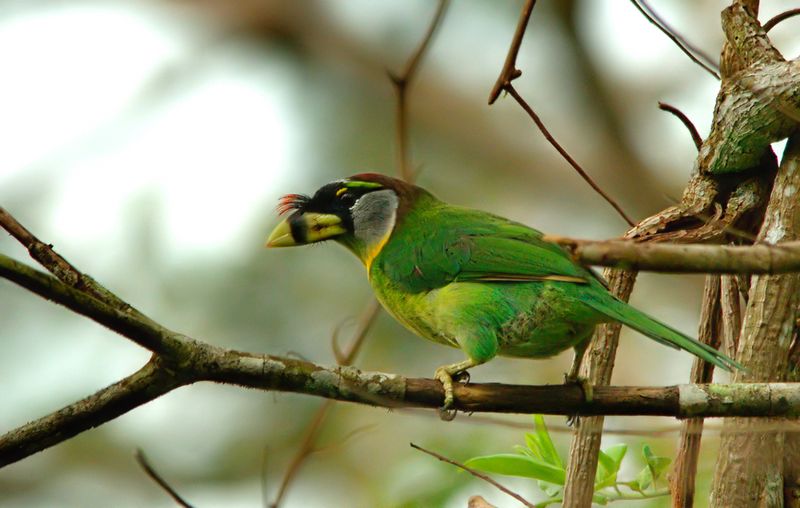
Megalaimidae is a family of birds commonly known as Asian barbets. It is composed of two genera, which together include 34 species of birds native to the Indomalayan realm, a biogeographic region extending from Tibet to Indonesia.
This vast area encompasses a range of different habitats, from tropical rainforests to alpine meadows. The Asian barbets of the Megalaimidae family are colorful birds, typically sporting bright yellow and green feathers.
They have large heads with stout, ridged bills, and small, round bodies. They are also known for their loud, repetitive vocalizations. Asian barbets are active birds, usually found in pairs or small groups in the canopy of the forest.
They mainly feed on fruit, but will also consume nuts, insects, and even small lizards. Asian barbets are considered to be a specialized group of birds, and many species are threatened or endangered due to habitat loss and hunting.
As a result, conservation efforts are underway to help preserve these birds and their habitats.
| Kingdom | Animalia |
| Phylum | Chordata |
| Class | Aves |
| Order | Piciformes |
| Family | Megalaimidae |
9. Brown-Cheeked Fulvetta
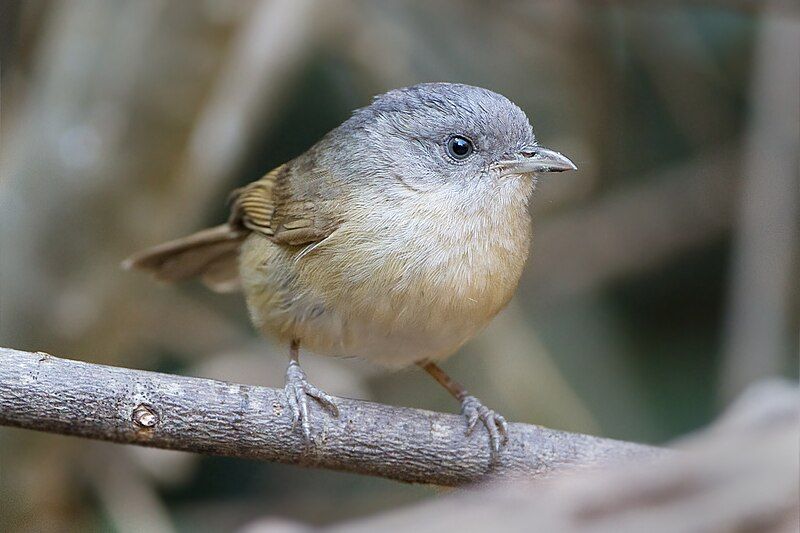
The brown-cheeked fulvetta, a species of bird belonging to the family Alcippeidae, is also known as the brown-cheeked alcippe. It is distinct from fulvettas proper, which are not closely related to the species. This bird was formerly referred to as the quaker babbler.
The brown-cheeked fulvetta is native to certain regions in Southeast Asia. It is a small bird with a length of around 11 cm and a weight of around 18g. Its plumage is mainly grey-brown with a white throat. It is generally found in the undergrowth of forests and bamboo thickets.
The brown-cheeked fulvetta is a non-migratory species and feeds on insects, spiders, fruit, and berries. The bird is usually found in pairs or small groups and is quite vocal, producing a variety of calls, trills, and whistles.
It is listed as “least concern” by the International Union for Conservation of Nature (IUCN). Overall, the brown-cheeked fulvetta is an interesting species of bird that has adapted to its habitat and environment in Southeast Asia.
Though it is not closely related to other fulvetta species, it is still considered a part of the Alcippeidae family. This bird was formerly known as the quaker babbler, though it is now more commonly referred to as the brown-cheeked fulvetta.
| Kingdom | Animalia |
| Phylum | Chordata |
| Class | Aves |
| Order | Passeriformes |
| Family | Alcippeidae |
| Genus | Alcippe |
| Species | A. poioicephala |
10. Leafbird
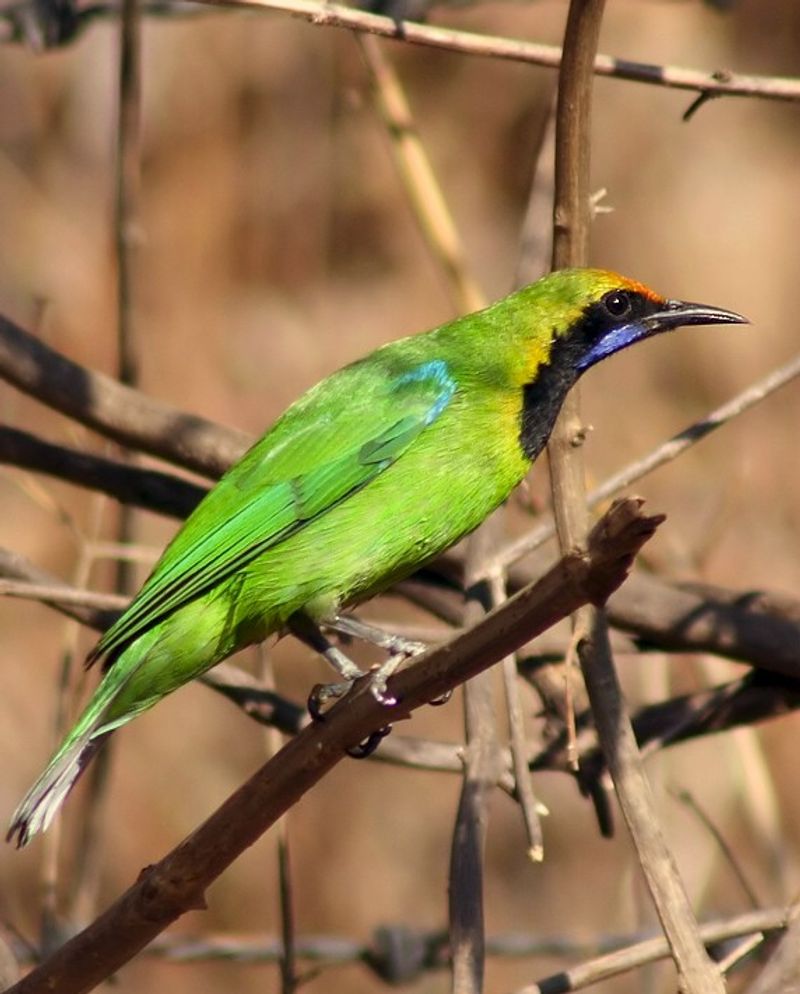
The Leafbird family is a group of small bird species that are found in the Indian Subcontinent and Southeast Asia. They were previously included in the Irenidae family, which also included Ioras and Fairy-Bluebirds.
However, nowadays the Leafbird family is considered to be a single genus, or monogenic, with all species placed within the genus Chloropsis. Leafbirds are usually brightly coloured, and the males of the species often display their vibrant feathers in courtship displays.
They are also known for their distinctive chirping sound, which is often heard in forests and jungles. Leafbirds are typically found in open forests, woodlands and scrub, but they also inhabit gardens and cultivated areas.
They are omnivorous, feeding on a range of fruits, flowers, insects, and other small invertebrates. They are also known to visit bird feeders in search of food.
Leafbirds are an important part of the avian biodiversity of the Indian Subcontinent and Southeast Asia and are a delight to watch in the wild.
| Kingdom | Animalia |
| Phylum | Chordata |
| Class | Aves |
| Order | Passeriformes |
| Family | Chloropseidae |
| Genus | Chloropsis |
11. Cuckooshrike
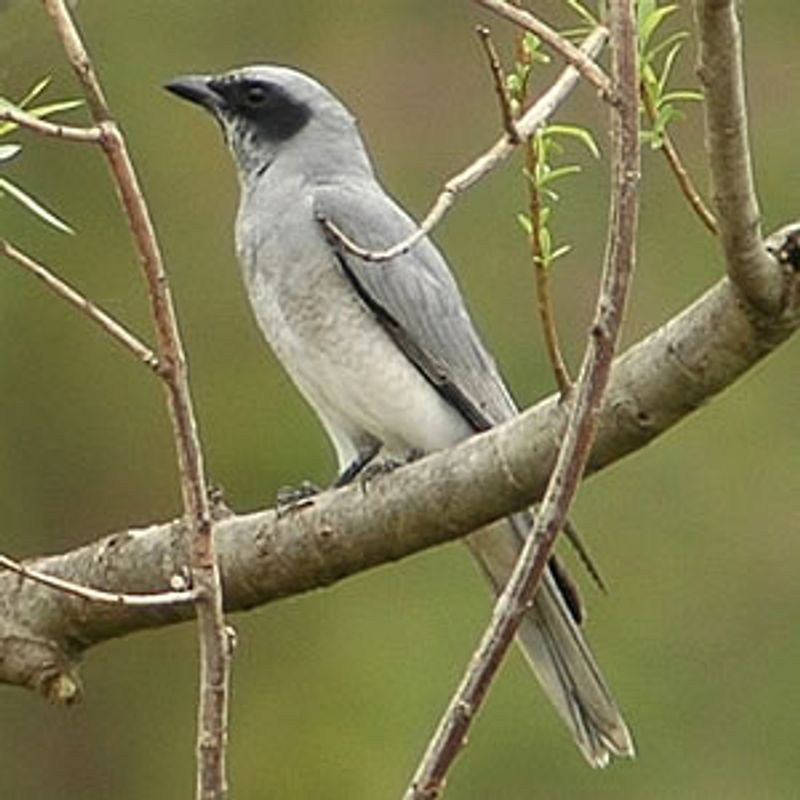
The Campephagidae family of birds is composed of small to medium-sized passerine species that inhabit subtropical and tropical regions of Africa, Asia, and Australasia. Commonly known as cuckooshrikes and allies, these birds are comprised of 93 species divided into 11 genera.
Cuckooshrikes and allies are distinguished by their unique appearance, including their small to medium-sized bodies, often with a long, thin tail. They also have short, rounded wings and a short, conical bill.
The plumage of the birds in this family is diverse and can range from grey to brown, white, and even black. These birds are commonly found in a wide variety of habitats, such as woodlands, forests, and scrublands.
They prefer to forage in trees, and their diet consists mainly of insects and fruit. Cuckooshrikes and allies are monogamous and usually territorial, with each pair defending its own territory.
They are also known to be quite vocal, with a variety of melodic calls and songs heard throughout the day.
In conclusion, the Campephagidae family of birds is an incredibly diverse family of passerines that are found in many subtropical and tropical regions of Africa, Asia, and Australasia.
With 93 species divided into 11 genera, cuckooshrikes and allies are easily one of the most interesting bird groups in the world.
| Kingdom | Animalia |
| Phylum | Chordata |
| Class | Aves |
| Order | Passeriformes |
| Family | Campephagidae |
12. Jacanas
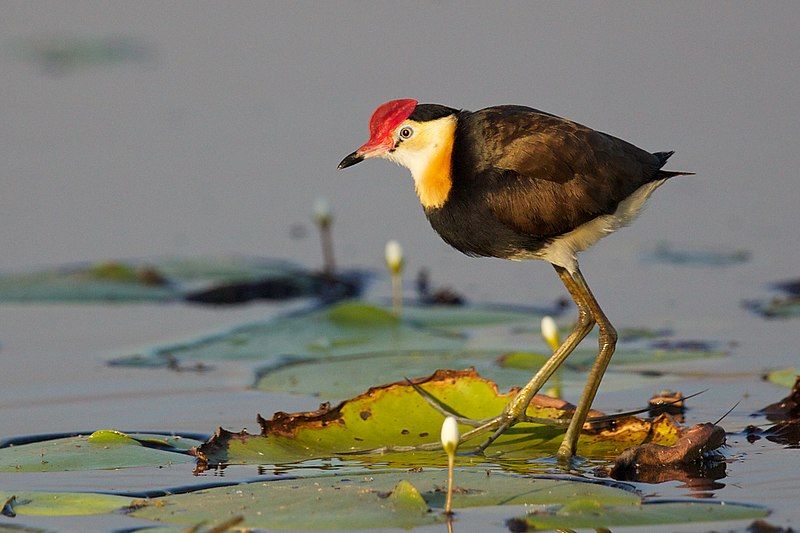
Jacanas are unique wading birds found in tropical areas around the world. They are members of the Jacanidae family and are easily identified by their long toes and toenails.
These physical adaptations help them to forage for food in floating or partly submerged aquatic vegetation.
By spreading out their weight over a larger area, they can move over the vegetation without sinking. The jacanas primarily feed on small aquatic insects, frogs, fish, and other small aquatic creatures. They also consume some plant material, such as seeds and fruits.
They are usually found in shallow water, where they can quickly spot their prey and scurry away if a predator approaches. The jacanas are also known for their elaborate courtship rituals.
The males often call for the females with loud calls and perform elaborate displays of feathers and wings. During the breeding season, the male will build a nest and defend it against other males.
He will then court the female and attempt to win her over with his courtship display. Overall, the jacanas are an amazing group of birds that have adapted to their tropical environment.
They are able to survive and thrive in their habitats thanks to their unique physical features and behavior.
| Kingdom | Animalia |
| Phylum | Chordata |
| Class | Aves |
| Order | Charadriiformes |
| Family | Jacanidae |
13. Pittas
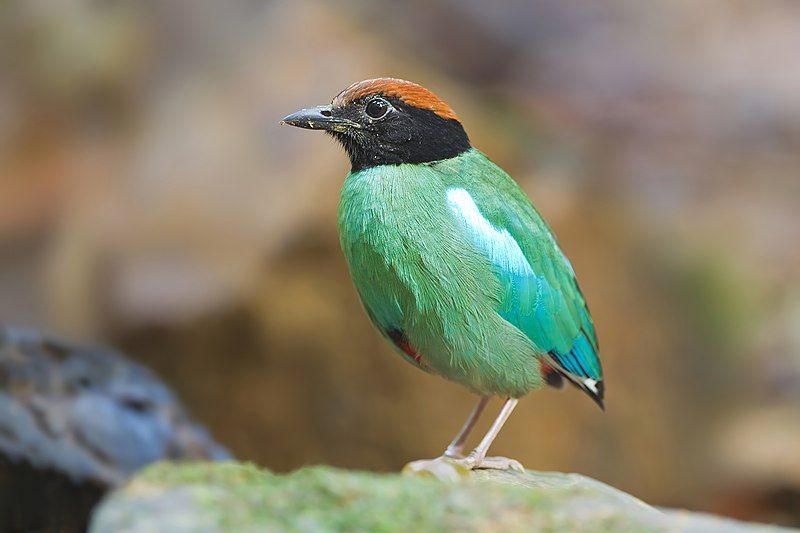
Pittas are a family of passerine birds, known scientifically as Pittidae, that can be found in Asia, Australasia and Africa. There are around 44 species of pittas, all of which share similar physical features and behaviors.
They are part of a group of birds known as Old World suboscines, which are closely related to other birds in the Smithornis and Calyptomena genera. Pittas have short wings and a long tail and are usually brightly colored with iridescent blues, greens and reds.
They are terrestrial birds that typically inhabit humid forests, and feed on a variety of insects, spiders, small lizards and other invertebrates. They are typically seen alone or in pairs and are renowned for their loud and melodic calls.
Pittas are an important part of the ecosystem, as they help to control insect populations and disperse seeds.
| Kingdom | Animalia |
| Phylum | Chordata |
| Class | Aves |
| Order | Passeriformes |
| Family | Pittidae |
14. Glareolidae
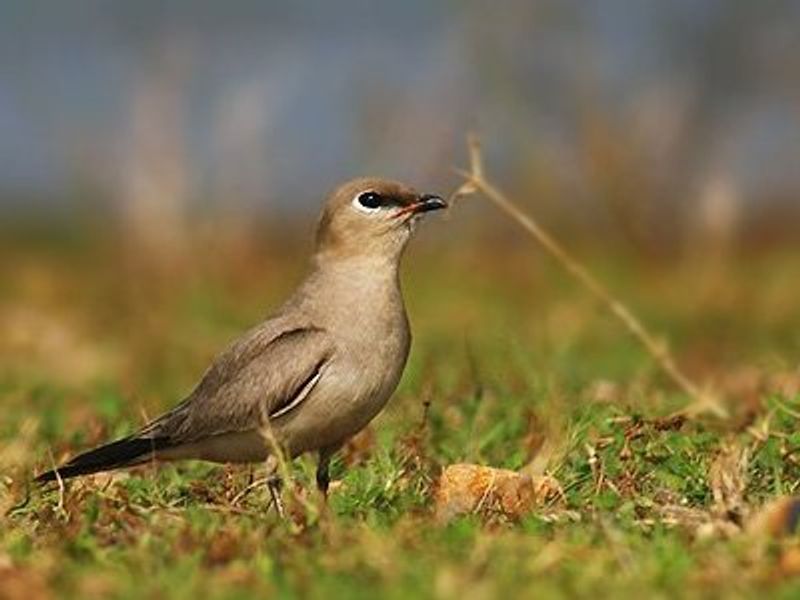
Glareolidae is a family of birds that belong to the wader suborder Charadrii. This family is made up of two distinct groups, the pratincoles and the coursers. Pratincoles are generally small birds, known for their short legs and long wings.
They are typically found in open grasslands, where they feed on insects. Coursers, on the other hand, are larger birds with long legs and short wings. They usually inhabit open grasslands or scrublands and feed on larger prey such as lizards and rodents.
The family also contains a unique species of bird, the Egyptian plover. Although traditionally placed in this family, recent studies have shown that it is only distantly related. Overall, the Glareolidae family consists of 17 different species across four genera.
Despite the small number of species, the pratincoles and coursers are widely distributed around the world, with each group having several species found in different habitats.
| Kingdom | Animalia |
| Phylum | Chordata |
| Class | Aves |
| Order | Charadriiformes |
| Family | Glareolidae |
15. Stone-Curlew
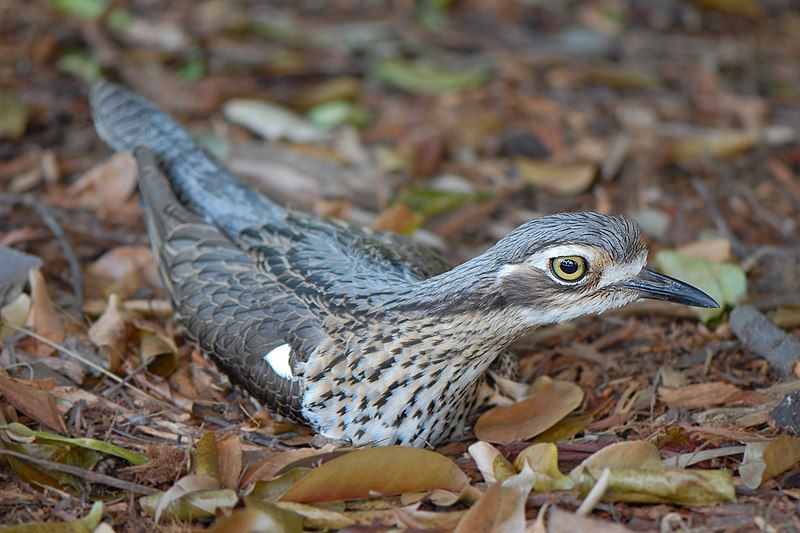
The stone-curlews are a family of birds found in tropical and temperate regions around the world. They are also known as dikkops or thick-knees and are made up of 10 species in the family Burhinidae.
In Africa, Asia, and Australia there are usually two or more species located in each area, making them one of the most widely distributed bird species. Stone curlews are usually found in open grasslands, savannas, and wetlands.
They are adapted to life on the ground and have long legs, which give them the appearance of being ‘thick-kneed’. They also have sharp eyesight, and can easily spot their prey from a distance.
They have a wide variety of diets, consisting of invertebrates and small vertebrates. Stone curlews have a unique breeding ritual that includes a courtship dance. During the dance, the male and female will move around in circles while bowing and bobbing their heads.
Once the male has been accepted, they will build a nest together in a shallow depression on the ground. The female will lay a clutch of eggs and both parents will incubate them until the chicks are ready to hatch.
The stone-curlews are an interesting family of birds that have adapted to life in a variety of environments. Their wide distribution, unique courtship ritual, and varied diet make them an interesting species to observe and study.
| Kingdom | Animalia |
| Phylum | Chordata |
| Class | Aves |
| Order | Charadriiformes |
| Family | Burhinidae |
16. Painted-Snipe
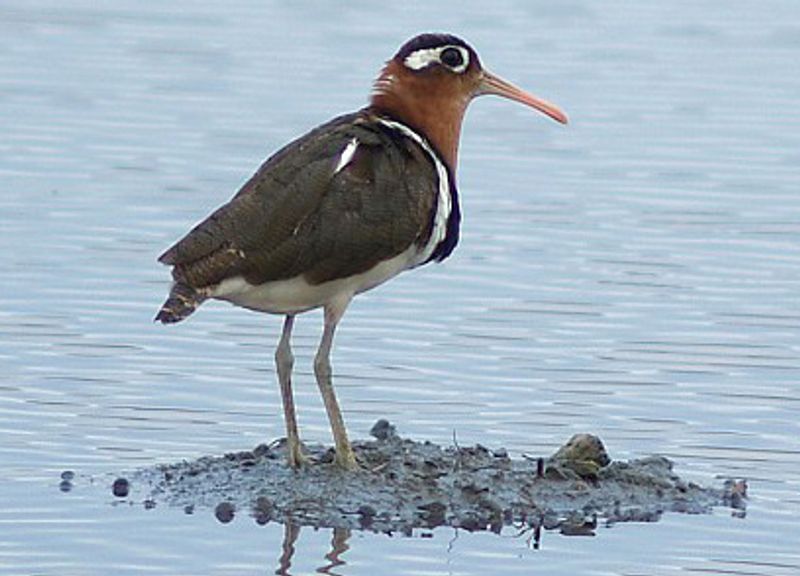
The Rostratulidae family is a unique type of wading bird consisting of two distinct genera: Rostratula and Nycticryphes. These birds, commonly known as the painted snipes, are found in tropical and subtropical regions of the world and have a distinctively long, thin bills.
They feed mainly on insects, small fish, and other invertebrates that can be found in shallow bodies of water. Painted snipes typically have a mottled or striped color pattern on their upperparts, which helps them to blend into their environment and remain hidden.
They are also quite vocal, making a variety of calls and whistles. The two genera of the Rostratulidae family differ in size and coloration. Rostratula species are typically smaller than Nycticryphes species and have more subdued coloration.
Nycticryphes species, on the other hand, are larger and often have bolder and brighter coloration.
Both genera have long legs and feet which enable them to wade through shallow water and search for food.The painted-snipes of the Rostratulidae family are an amazing species of wading bird and play an important ecological role in their environment.
They provide food for other species, such as fish and frogs, and help to keep insect populations under control. These birds are also an important source of food for many cultures around the world, and their meat is often used in traditional dishes.
Although their numbers are in decline due to habitat destruction, conservation efforts are being made to protect these unique birds and their habitats.
| Kingdom | Animalia |
| Phylum | Chordata |
| Class | Aves |
| Order | Charadriiformes |
| Family | Rostratulidae |
17. Bustard
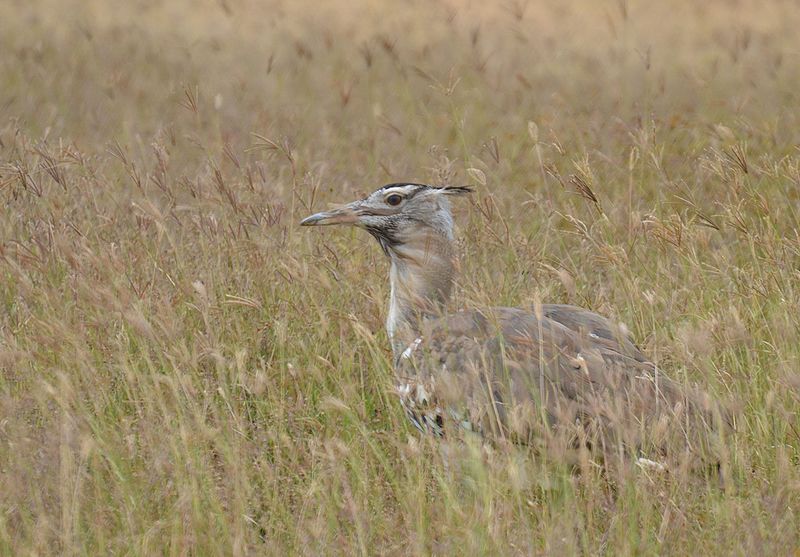
Bustards are a type of large bird found throughout the Old World. They are members of the family Otididae and can range in length from 40 to 150 centimeters. These birds are typically found in dry grasslands and steppes and are well adapted to living in these areas.
They are well known for their long legs and powerful wings, which allow them to fly for long distances. The most common types of bustards found in the Old World are floricans and korhaans. These two species are closely related, but they have some distinct differences.
The florican has a brownish-black coloration and a curved crest on its head, while the korhaan is grey-brown in color and has a straight crest. Both species are monogamous and tend to mate for life. Bustards are omnivores, meaning that they feed on both animal and plant matter.
Their diet typically consists of insects, small mammals, snakes, and various types of vegetation.
They can also sometimes be seen foraging in fields and pastures. Bustards are threatened by habitat loss and hunting, leading to their conservation status being listed as vulnerable in some parts of their range.
As such, it is important to protect their habitats in order to ensure their continued survival.
| Kingdom | Animalia |
| Phylum | Chordata |
| Class | Aves |
| Clade | Otidimorphae |
| Order | Otidiformes |
| Family | Otididae |
18. Threskiornithidae
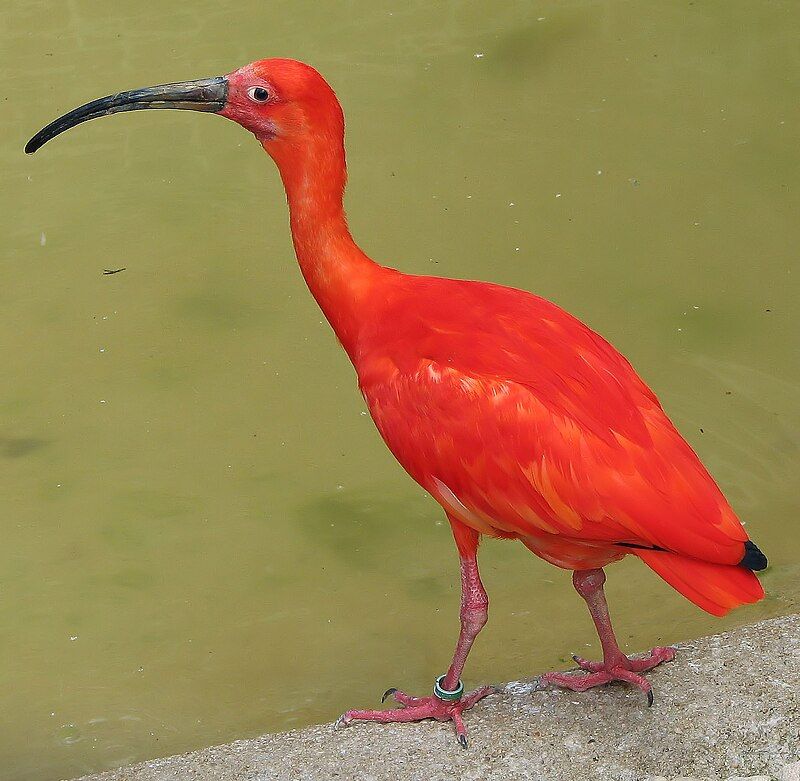
The family Threskiornithidae is a family of large wading birds that consists of 36 species. This family is traditionally divided into two subfamilies: the ibises and the spoonbills.
The ibises are characterised by a long, curved bill, which they use to seek out food in shallow waters.
Meanwhile, the spoonbills have a broad, spoon-shaped bill, which they use to filter food from the water. Recent genetic studies have suggested that the traditional classification of the Threskiornithidae family is not accurate.
These studies have suggested that the two subfamilies do not share a common ancestor, and that the family is more accurately divided into three distinct groups.
These include the ibises, the spoonbills, and a third group that consists of a number of species that do not fit into either category. This new taxonomic classification provides a more accurate representation of the Threskiornithidae family.
| Kingdom | Animalia |
| Phylum | Chordata |
| Class | Aves |
| Order | Pelecaniformes |
| Family | Threskiornithidae |
19. Stilts and Avocets
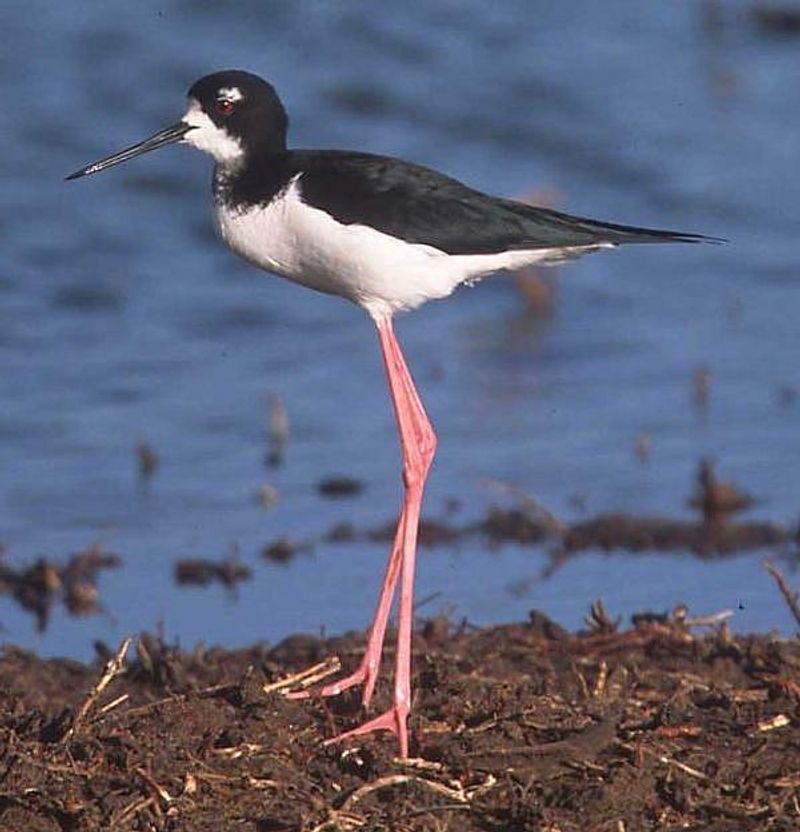
The Recurvirostridae family is composed of two distinct bird groups – avocets and stilts. Avocets are characterized by their long, thin, and upturned bills. They usually have black and white plumage and long legs.
Stilts are also known for their long legs, but their bills are straighter and shorter than avocets. They have brightly colored plumage in various shades of brown, gray, and black.
Both avocets and stilts belong to the wader suborder Charadrii, which is comprised of shorebirds that feed on aquatic animals. These birds typically inhabit coastal wetlands, shallow lakes, and other areas with shallow water.
They can be found in many parts of the world, but are most common in tropical and subtropical regions. The Recurvirostridae family is an important part of the ecosystem, providing food for many fish, amphibians, and reptiles.
| Kingdom | Animalia |
| Phylum | Chordata |
| Class | Aves |
| Order | Charadriiformes |
| Family | Recurvirostridae |
20. Darters
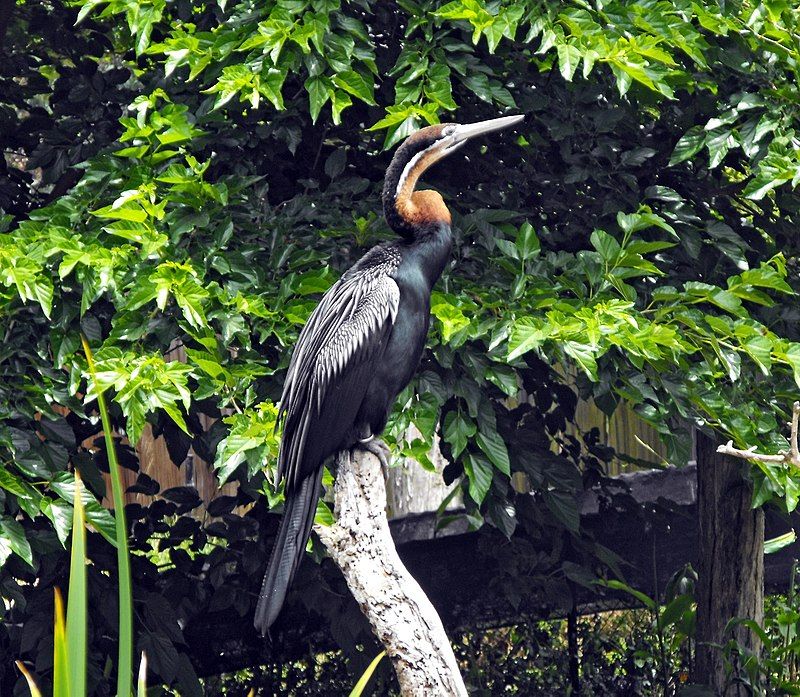
The darters, anhingas, or snakebirds are waterbirds in the family Anhingidae, which contains a single genus, Anhinga. There are four species of these birds, three of which are very common and widespread.
These species can be found in tropical regions around the world, and they are not endangered. The fourth species is rarer and is classified as near-threatened by the International Union for Conservation of Nature (IUCN).
This species is not as widely distributed as the other three species, and its population is in decline due to habitat loss and other factors. Conservation efforts are needed to protect this species from becoming endangered.
| Kingdom | Animalia |
| Phylum | Chordata |
| Class | Aves |
| Order | Suliformes |
| Family | Anhingidae |
| Genus | Anhinga |
21. White-Eyes
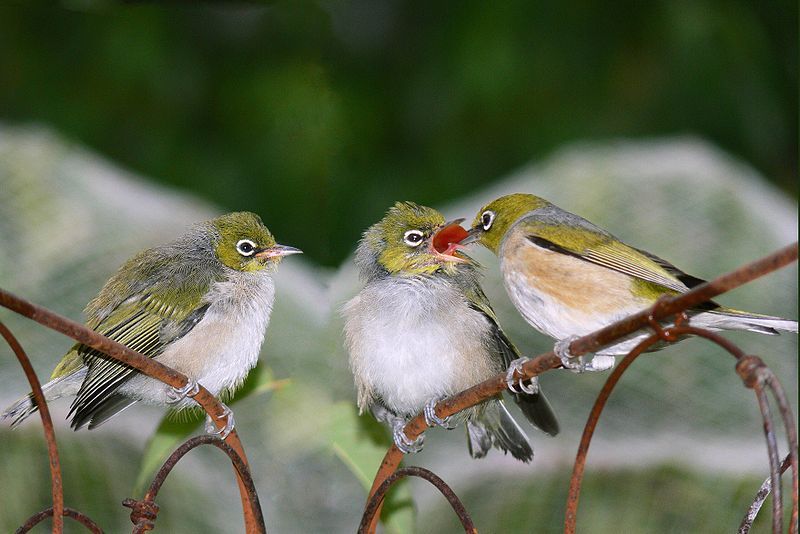
The White-eyes are a group of small, passerine birds that are found in a variety of places around the world. They are part of a family of birds called Zosteropidae, which is native to Sub-Saharan Africa, southern and eastern Asia, and Australasia.
White-eyes are typically found in tropical and subtropical habitats, and they are also known to inhabit temperate areas.
They have adapted to live in many different locations, and can be found in most tropical islands in the Indian Ocean, the western Pacific Ocean, and the Gulf of Guinea. These birds have a distinctive white eye-ring, which is where they get their name from.
White-eyes are typically small birds ranging in size from 4 to 6 inches long, and they are usually green or yellow in color. They are highly social birds, and can often be found in flocks of up to several hundred individuals.
They feed on a variety of insects, fruits, and other small invertebrates. White-eyes are an important species in many ecosystems, as they help to control insect populations and disperse seeds.
| Kingdom | Animalia |
| Phylum | Chordata |
| Class | Aves |
| Order | Passeriformes |
| Family | Zosteropidae |
22. Sylviid Warblers
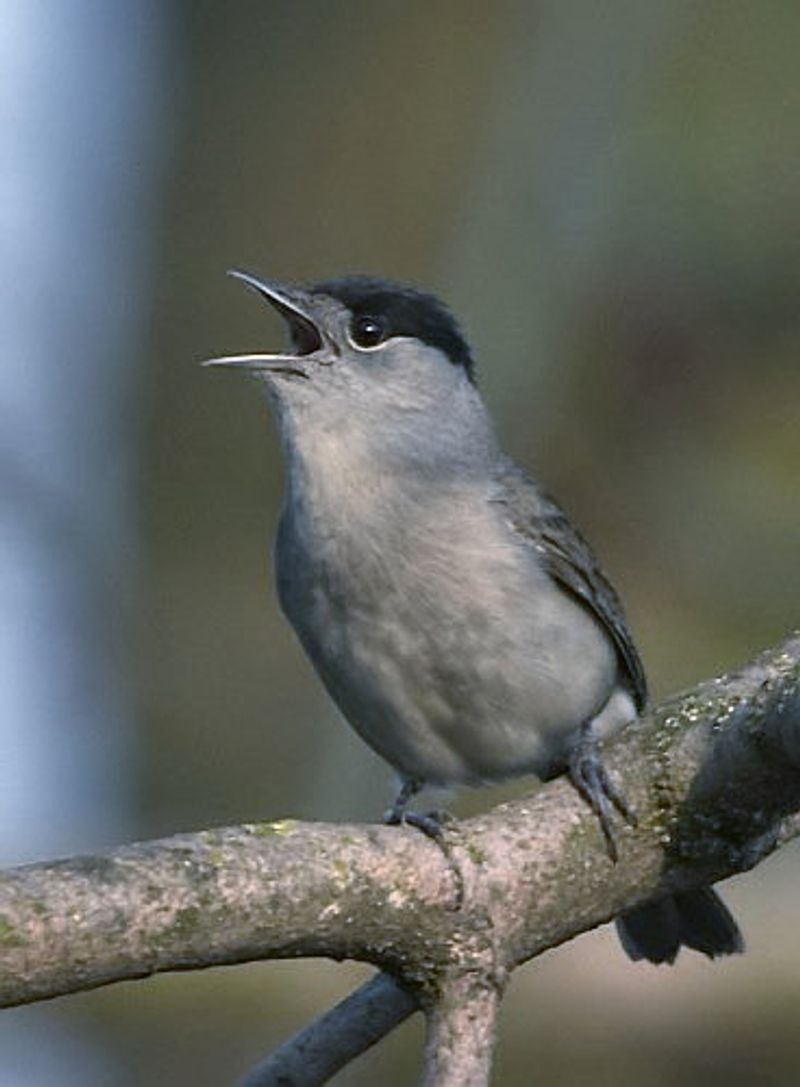
Sylviidae is a family of passerine birds, which are also known as songbirds or perching birds. These birds are found in Eurasia and Africa, and they are characterized by their strong, hooked beaks, short wings, and long legs.
The family includes the typical warblers, which are small birds with colorful plumage and melodic songs, as well as a number of babblers.
These babblers were formerly placed within the Old World babbler family, which is a larger group of birds that are found across Asia, Europe, and Africa. Sylviidae birds have a wide range of behaviors, from the more sedentary habits of the typical warblers to the more active and noisy behavior of the babblers.
They feed on insects, fruits, and seeds, and they can often be found near water sources.
They prefer to live in wooded areas and scrublands, where they are able to find protection from predators and plenty of food sources. The Sylviidae family of birds is an important part of the global ecosystem.
They act as pollinators and seed dispersers, helping to maintain healthy habitats for many other species. They also provide food for many other animals, including birds of prey, which helps to keep the balance of the food chain in check.
| Kingdom | Animalia |
| Phylum | Chordata |
| Class | Aves |
| Order | Passeriformes |
| Family | Sylviidae |
23. Laughingthrushes
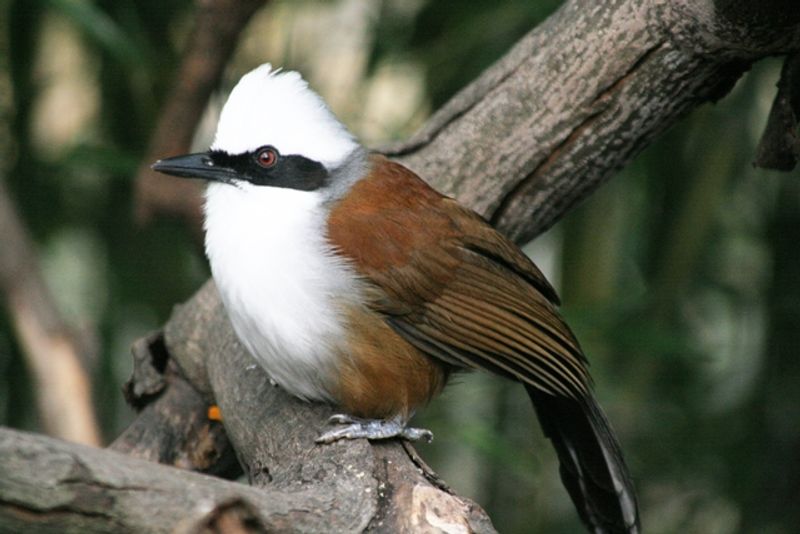
The laughingthrushes are a group of Old World passerine birds that make up the family Leiothrichidae. They come in a variety of sizes and colors, and are typically found in tropical parts of the world, especially Southeast Asia and the Indian subcontinent.
This family of birds was historically classified as part of the Old World babbler family, Timaliidae, which is a larger family of birds.
The laughingthrushes, however, are now considered a separate family due to the distinct characteristics that separate them from other babblers.
These birds are known for their unique vocalizations, which are often described as “laughing” or “chuckling.” Additionally, they have longer legs and tails than other babblers, and they feed on a variety of fruits, insects, and small animals.
As a result of their distinct features and behaviors, the laughingthrushes are now classified as a separate family.
| Kingdom | Animalia |
| Phylum | Chordata |
| Class | Aves |
| Order | Passeriformes |
| Family | Leiothrichidae |
24. Treecreepers
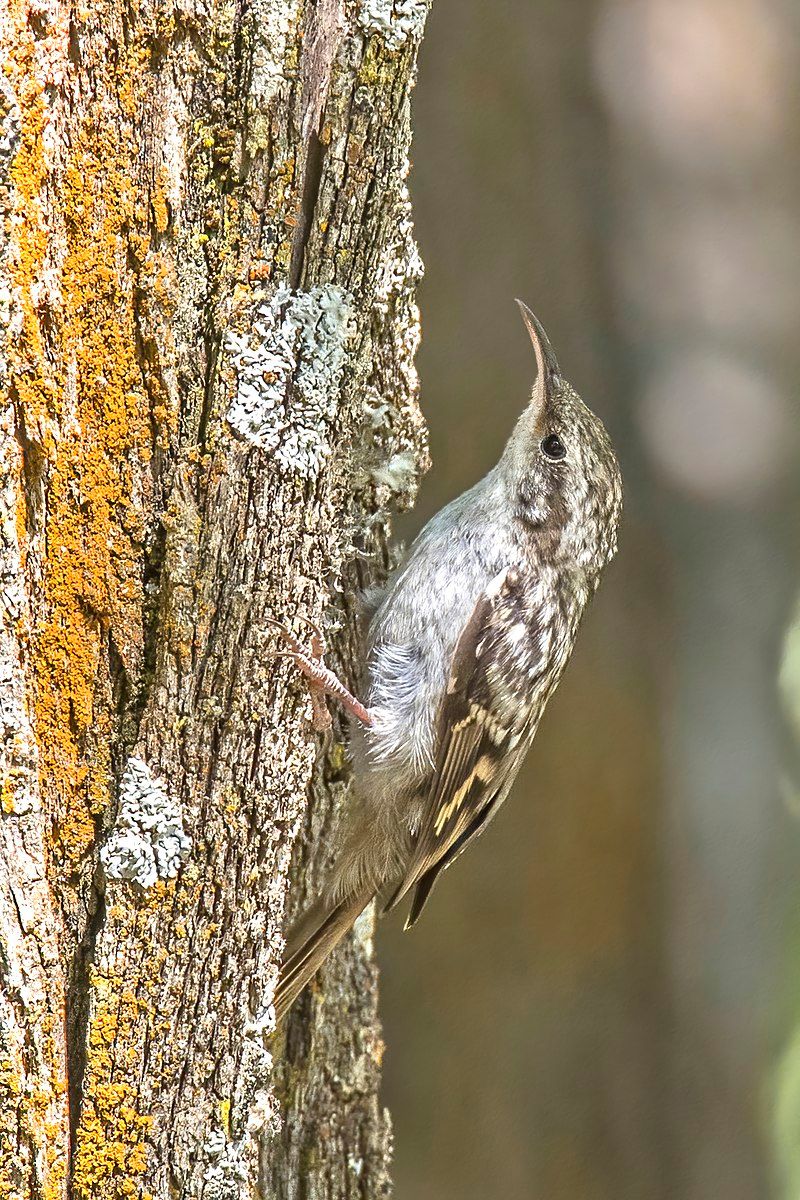
The treecreepers are a family of small birds that are found in various wooded regions of the Northern Hemisphere and sub-Saharan Africa. This family, called Certhiidae, consists of eleven species, classified into two genera: Certhia and Salpornis.
These birds typically have long, curved beaks and strong toes that allow them to climb up the trunks and branches of trees in search of food, such as insects and larvae. They are usually found in forests but can also be seen in gardens and other areas with trees and shrubs.
Treecreepers are quite common in Europe but are less common in North America. They are usually solitary birds but have been known to form small flocks during the winter months. They are generally shy and secretive, and will quickly fly away if disturbed.
| Kingdom | Animalia |
| Phylum | Chordata |
| Class | Aves |
| Order | Passeriformes |
| Family | Certhiidae |
25. Treeswift
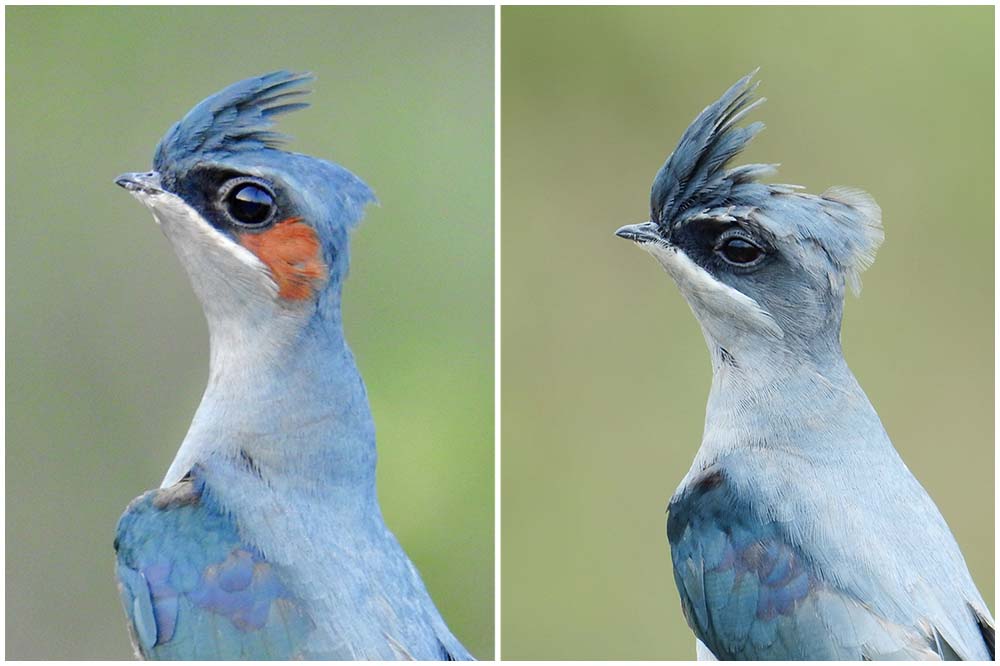
Treeswifts, or crested swifts, are a type of bird from the family Hemiprocnidae. This family is closely related to the true swifts, and contains only one genus, Hemiprocne.
This genus is made up of four species, which are found in India, Southeast Asia, Indonesia, New Guinea, and the Solomon Islands.
These birds are aerial, meaning they spend much of their time in the air, and are near passerine, meaning they are similar to the passerines, or perching birds. Treeswifts are small birds, with long wings and fork-shaped tails.
They are distinguished by their crests, which are tufts of feathers on the tops of their heads. As their name implies, they often make their nests in the trees.
They feed on insects, which they catch in mid-air, and have a high-pitched call which can be heard over long distances. Treeswifts are important members of their ecosystems, as they help to control insect populations.
They are also of great interest to ornithologists, as they are the only members of the Hemiprocnidae family. As such, they provide an important link between two different groups of birds.
| Kingdom | Animalia |
| Phylum | Chordata |
| Class | Aves |
| Clade | Strisores |
| Order | Apodiformes |
| Family | Hemiprocnidae |
| Genus | Hemiprocne |
26. Weavers
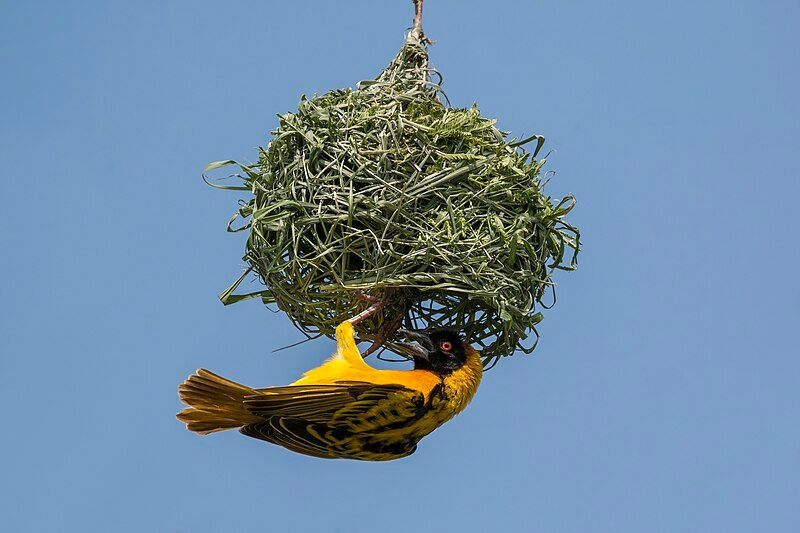
Ploceidae is a family of small passerine birds, commonly known as weavers, weaverbirds, weaver finches, or bishops. These birds are named for the intricate nests they build out of vegetation.
The nests are woven together with remarkable skill and precision, giving the birds their common names. The birds use a variety of plants and materials to construct their nests, often weaving them together in complex patterns.
These nests are crucial for the birds’ survival, providing shelter from the elements and predators. The nests also provide a safe place to lay eggs and raise young.
The weaving ability of these birds makes them unique among other passerine birds, and it is a trait that has made them beloved among birdwatchers and nature enthusiasts around the world.
| Kingdom | Animalia |
| Phylum | Chordata |
| Class | Aves |
| Order | Passeriformes |
| Family | Ploceidae |
27. Flowerpecker
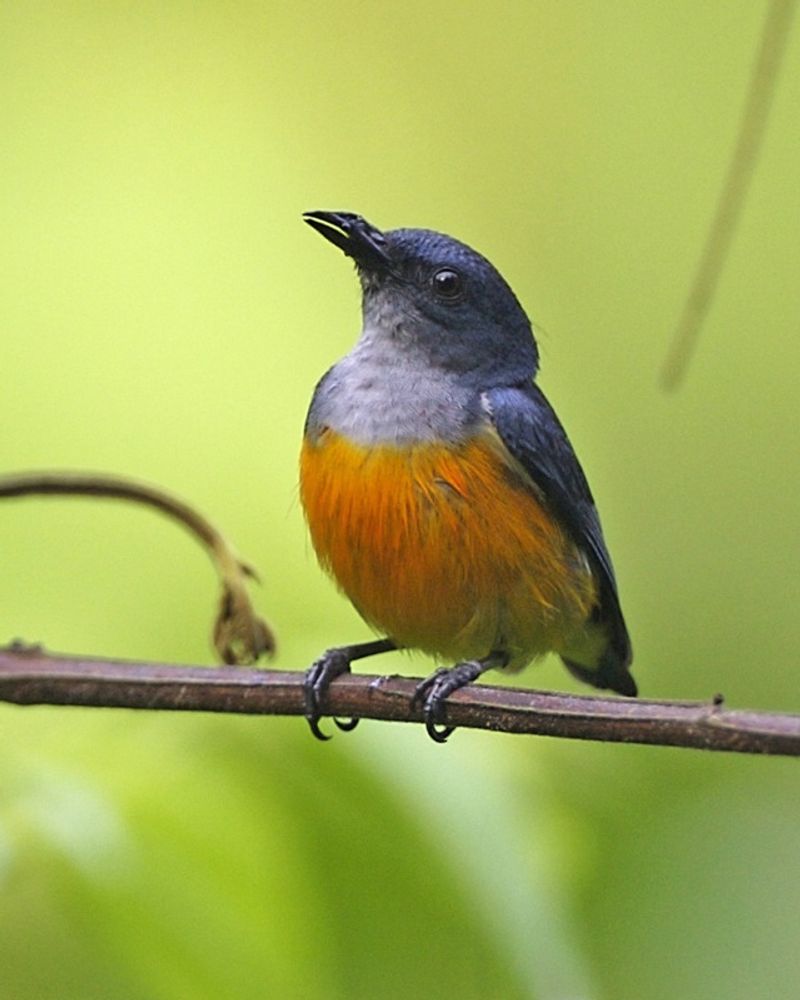
The flowerpeckers are a family of passerine birds, known as Dicaeidae. This family is made up of two genera, Dicaeum and Prionochilus, which contain a total of 50 species.
Flowerpeckers are related to sunbirds, although they are sometimes considered to be part of a larger sunbird family, Nectariniidae, which also includes the honeyeaters. Flowerpeckers are usually small, brightly colored birds with short, stubby bills and long tails.
They are mostly found in tropical and subtropical regions of the Old World, such as Asia, Africa, and Australia. The majority of species feed mainly on nectar, but some also eat insects and fruit.
They are commonly seen in gardens and parks, where they often form large flocks to take advantage of the abundance of food.
| Kingdom | Animalia |
| Phylum | Chordata |
| Class | Aves |
| Order | Passeriformes |
| Family | Dicaeidae |
29. Pelecaniformes
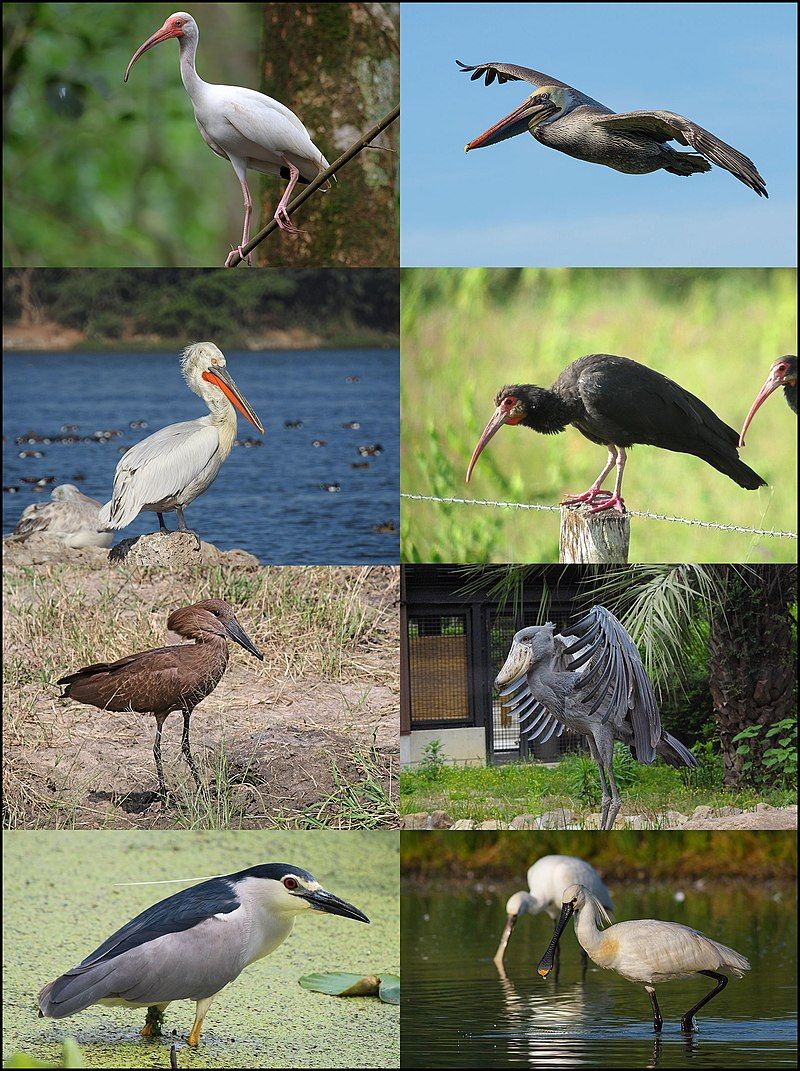
The Pelecaniformes, also known as totipalmates or steganopodes, are an order of waterbirds found all over the world. These birds range in size from medium to large. Traditionally, they have been defined by the presence of four webbed toes on their feet.
This definition, however, is incorrect, as there are some species of birds in the order that do not have all four of their toes webbed. The name Pelecaniformes comes from the Latin word “pelecanus,” meaning pelican.
This is because pelicans are the most well-known and abundant members of the order. Members of the Pelecaniformes can be found in both freshwater and saltwater habitats.
They are generally found in shallow water, where they can feed on aquatic invertebrates, fish, and small amphibians. The most distinctive feature of the birds in this order is their long, flexible neck and large bill, which allows them to reach food in deeper water.
Although many birds in this order are threatened by human activities such as overfishing, hunting, and habitat destruction, some species are still common, such as the American white pelicans.
| Kingdom | Animalia |
| Phylum | Chordata |
| Class | Aves |
| Clade | Aequornithes |
| Order | Pelecaniformes |
30. Coraciiformes
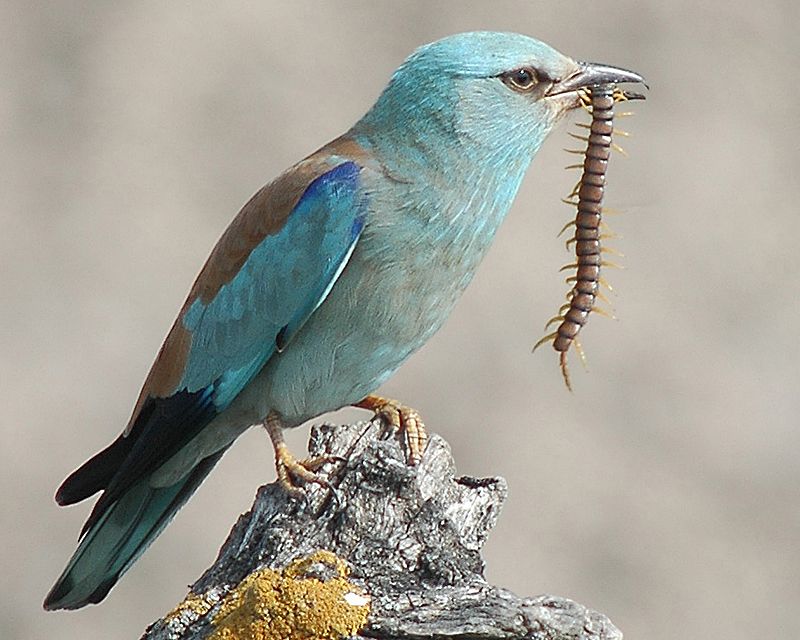
The Coraciiformes is an order of birds which includes some of the most recognizable and brightly colored species. These include the kingfishers, bee-eaters, rollers, motmots, and todies.
They have a particular type of feet, called syndactyly, which means that they have three toes pointing forward. This is the case for most of these birds, but some kingfishers have only two toes instead of three.
This adaptation is most likely due to the fact that kingfishers spend a lot of time in the water, and having fewer toes makes it easier for them to swim. The bright colors of the Coraciiformes are also thought to be an adaptation, as it helps them to stand out and attract mates.
The colors also help them with camouflage against potential predators. In general, the Coraciiformes are a diverse and fascinating group of birds, and they play an important role in the ecosystem.
| Kingdom | Animalia |
| Phylum | Chordata |
| Class | Aves |
| Clade | Picodynastornithes |
| Order | Coraciiformes |
31. Leaf Warbler
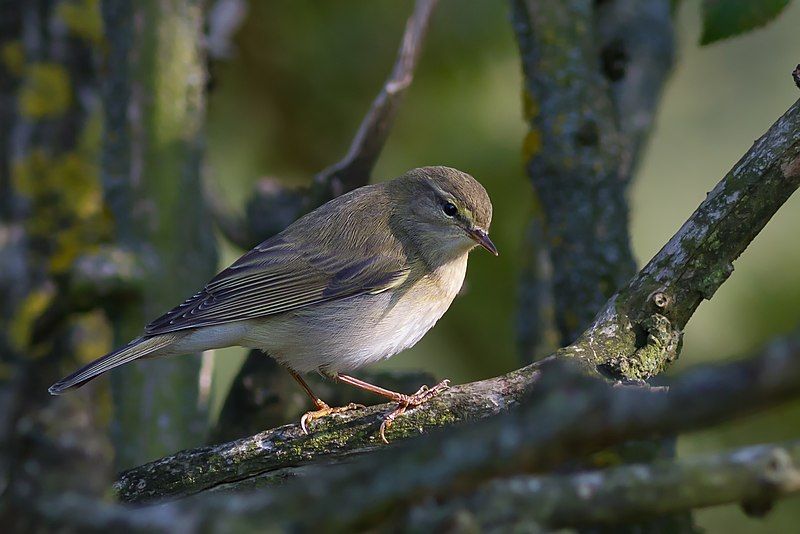
Leaf warblers are small birds typically found in Europe, Asia, and Africa. They are insectivorous, meaning that they feed on insects, and passerine, meaning that they belong to the order Passeriformes, which includes most of the perching birds.
Leaf warblers are part of the genus Phylloscopus, which is a group of birds that are often found in woodlands and are known for their habitats in leafy trees.
Until recently, leaf warblers were included in the Old World warbler family, which is a diverse group of birds that live in the Old World and include many species of warblers, flycatchers, and thrushes.
However, in 2006, the family Phylloscopidae was introduced, and leaf warblers were moved to this family. The Phylloscopidae family includes many species of leaf warblers, as well as other species of warblers and some flycatchers.
This new family has enabled scientists to better study the different species and their behaviors.
| Kingdom | Animalia |
| Phylum | Chordata |
| Class | Aves |
| Order | Passeriformes |
| Family | Phylloscopidae |
| Genus | Phylloscopus |
32. Piciformes
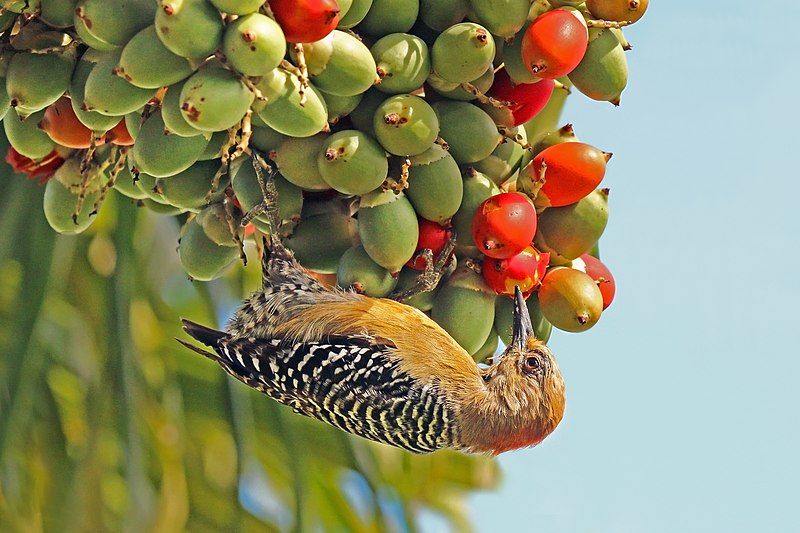
Piciformes is an order of birds that consists of nine families. The most well-known of these families is the Picidae, which is made up of woodpeckers and their close relatives. The Piciformes order includes a total of 71 living genera and about 450 species.
The Picidae family comprises roughly half of these species. This order of birds is largely arboreal, meaning that they live in trees and forests. These birds use their sharp beaks to peck at the bark of trees in order to feed on insects and other food sources.
Additionally, they use their beaks to create their nests in tree hollows or cavities. Woodpeckers are perhaps the most recognizable members of the Piciformes order due to their unique features, such as their brightly-colored feathers and distinctive call.
| Kingdom | Animalia |
| Phylum | Chordata |
| Class | Aves |
| Clade | Picodynastornithes |
| Order | Piciformes |
33. Eurasian Reed Warbler
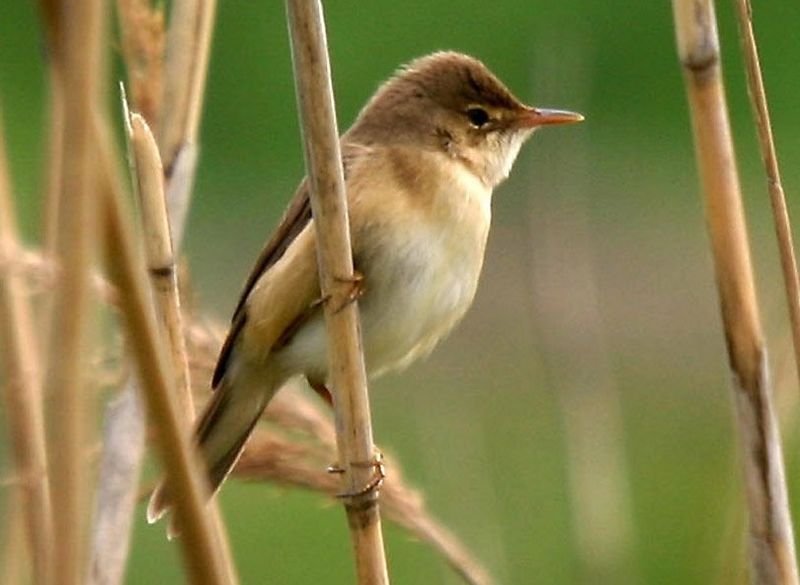
The common reed warbler is a species of bird belonging to the Old World warbler family, which is located in the genus Acrocephalus. It can be found in various areas of Europe, from the temperate western Palaearctic region to some of the more remote areas.
During the winter season, they migrate to the sub-Saharan region of Africa, where they can stay for the entire season.
There are also some reed warblers that are permanent residents of Africa, making their homes in large parts of the continent. These birds prefer wetland habitats, and their diet consists mainly of insects, molluscs, and other invertebrates.
They have a distinctive song, and they are known to build their nests near water. The female usually lays a clutch of 3-7 eggs which are incubated for 11-14 days.
After hatching, the young birds are cared for by both parents. The common reed warbler is an important species in many ecosystems, as they help to control insect populations. They also provide food for other animals, such as birds of prey.
Unfortunately, their populations have been declining due to habitat destruction and other human activities. Conservationists are working hard to protect and increase the numbers of these birds so that they can continue to play an important role in the environment.
| Kingdom | Animalia |
| Phylum | Chordata |
| Class | Aves |
| Order | Passeriformes |
| Family | Acrocephalidae |
| Genus | Acrocephalus |
| Species | A. scirpaceus |
34. Silktail
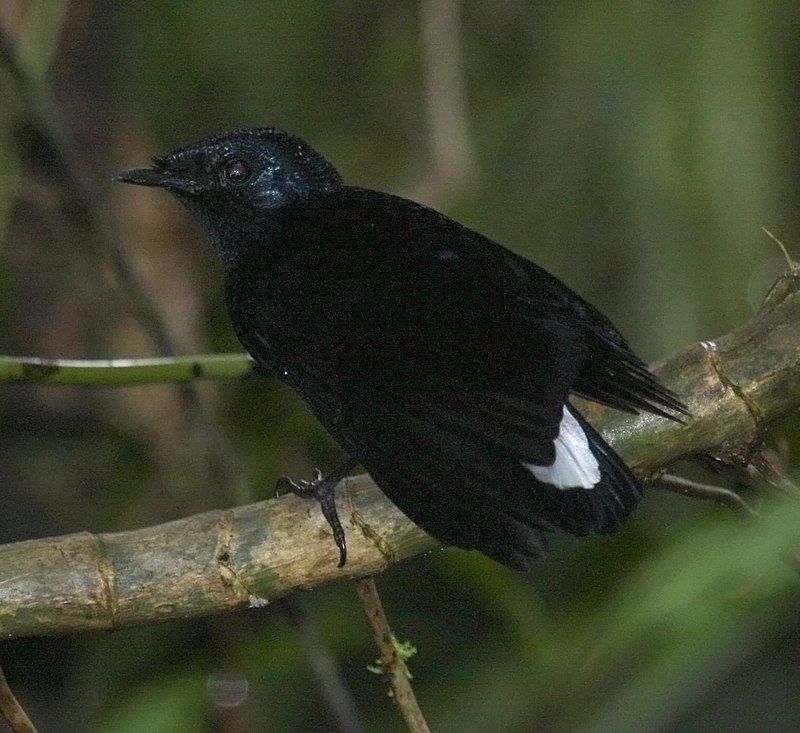
The silktails are a group of birds found only in Fiji. There are two species in this group, both belonging to the genus Lamprolia. Silktails are small birds that resemble bird-of-paradise, but they are actually more closely related to fantails.
Silktails are known for their bright colours and long tail feathers, which can be up to twice the length of their body. They mostly feed on insects, but some species may also eat fruit and small vertebrates.
Silktails are found in tropical lowland and montane forests, where they live in pairs or small family groups. They are shy and easily disturbed, so it can be difficult to spot them. These birds are important pollinators in Fiji, and their presence helps to promote biodiversity.
| Kingdom | Animalia |
| Phylum | Chordata |
| Class | Aves |
| Order | Passeriformes |
| Family | Rhipiduridae |
| Genus | Lamprolia |
35. Indian Roller
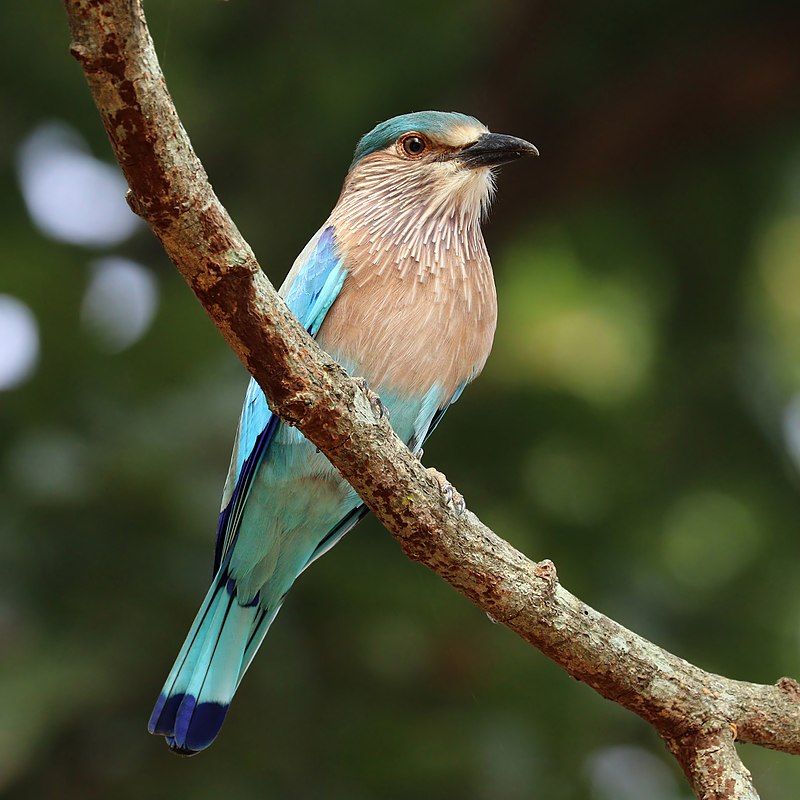
The Indian roller is a member of the Coraciidae family of birds. Its body length ranges from 30–34 cm, with a wingspan of 65–74 cm, and it usually weighs between 166–176 g.
The Indian roller has a unique and striking appearance; its face and throat are a pinkish color, while its head and back are brown. On its wings and tail, the Indian roller has an attractive contrast between light and dark blues.
The rump of the bird is also a vibrant blue color. All of these characteristics give the Indian roller an eye-catching look in the wild.
| Kingdom | Animalia |
| Phylum | Chordata |
| Class | Aves |
| Order | Coraciiformes |
| Family | Coraciidae |
| Genus | Coracias |
| Species | C. benghalensis |
36. Blue-Tailed Bee-Eater
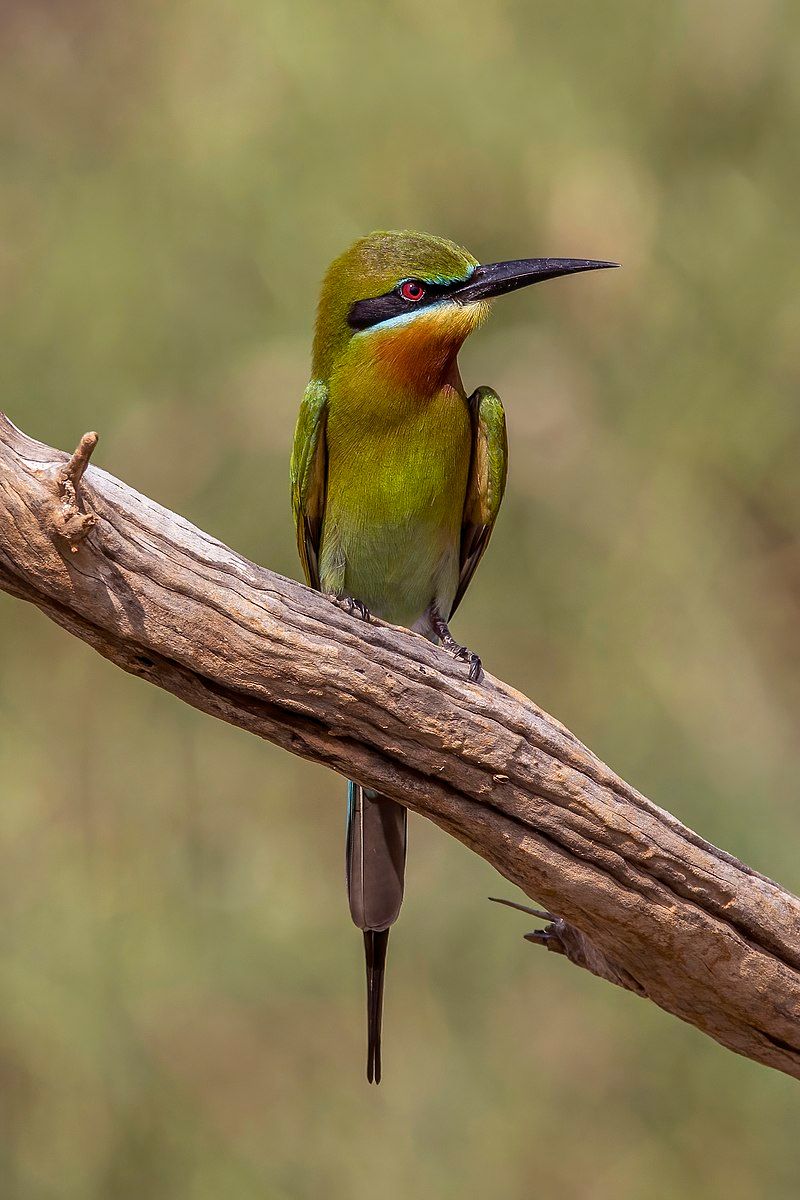
The blue-tailed bee-eater is a type of bird belonging to the family Meropidae. This species of bee-eater is found across South and Southeast Asia, where many of its populations migrate seasonally.
During these migrations, the birds are often seen in large flocks, moving between their breeding and wintering grounds. The bee-eater is a colourful bird, with a long, stout bill, blue upperparts and wings, and a bright yellow throat and breast.
Its distinctive tail is a mix of blue and green. The species feeds on insects, particularly bees and wasps, which it catches while in flight. It also eats other insects, such as flies and moths.
The blue-tailed bee-eater is an important species in its range, providing food for predators and helping to control insect populations.
| Kingdom | Animalia |
| Phylum | Chordata |
| Class | Aves |
| Order | Coraciiformes |
| Family | Meropidae |
| Genus | Merops |
| Species | M. philippinus |
Conclusion
The birds of Telangana are an integral part of the state’s biodiversity. With over 500 species of birds, Telangana is a great place for bird-watchers and nature lovers alike.
Whether you are visiting the state for a holiday or to explore the rich variety of birdlife, Telangana is sure to provide a unique and unforgettable experience. From the majestic Great Indian Hornbill to the beautiful Painted Stork, Telangana has something for everyone.
So don’t miss out on an opportunity to observe and appreciate the amazing birds of Telangana.